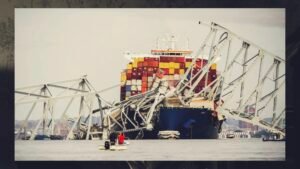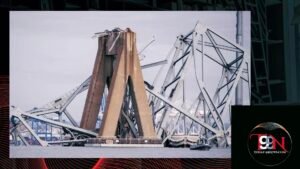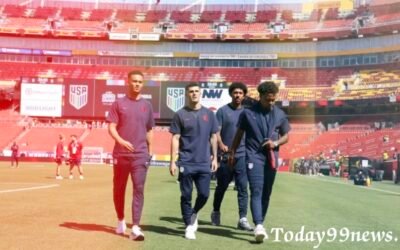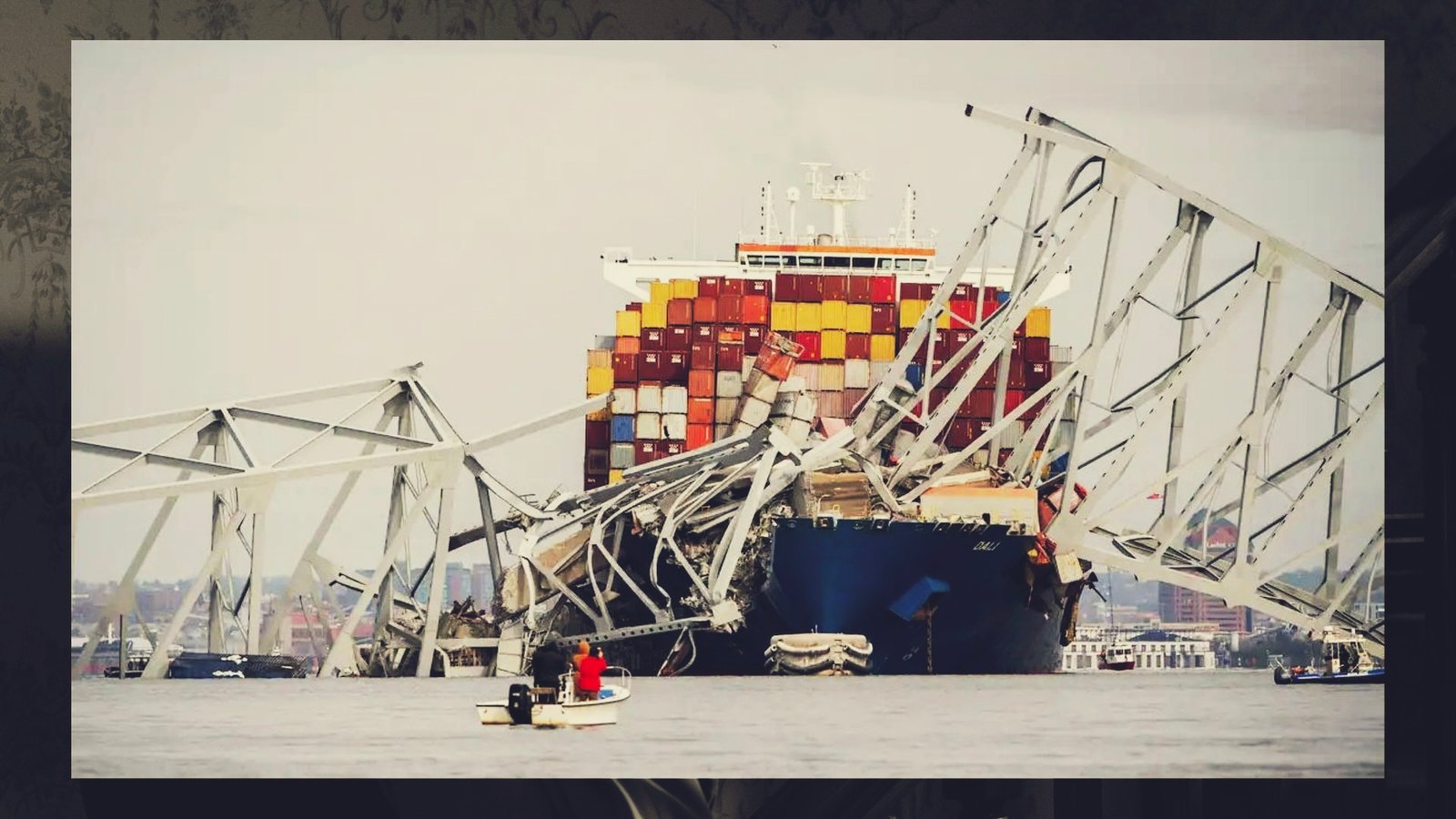Traffic on the Baltimore Bridge was stopped by the call from the ship “Maide,” saving lives.

The huge cargo ship, which closely resembles a giant city landscape, navigates dangerously near a major bridge in Baltimore, a vital artery that accommodates the passage of more than 30,000 vehicles on a daily basis. The crew immediately issued a “Mayday” on Tuesday in hopes of preventing a disaster.
First responders moved quickly, and at about 1:30 a.m., just before the 95,000-ton ship struck a span of the Francis Scott Key Bridge, shutting down most traffic, several spans buckled and collapsed, killing a large number of people. People got trapped. Trains. The horrifying scene was captured on camera.
Someone shouted over the emergency channel, “May Day, C13 dispatch, the entire bridge has collapsed!”
Although lives were saved and the quick action was described as courageous by Maryland Governor Wes Moore, the extent of the damage was catastrophic and will likely have a lasting impact on tourism and the state’s economy for months to come.
At least eight pothole-repair workers fell into the 48-degree Patapsco River, causing much of the 1.6-mile-long bridge to collapse. One suffered serious injuries, but two were saved. On Tuesday night, officials announced that six people were presumed dead and the search was suspended. The search for the victims was scheduled to resume Wednesday morning.
The incident resulted in the closure of the Port of Baltimore, one of the nation’s largest ports, and severed a vital artery that was part of Baltimore’s Beltway, a major thoroughfare connecting Washington and New York.
On behalf of the federal government, President Biden promised to accelerate and fund repairs.
The scene was one of utter destruction, with shipping containers spilled like tin cans, bridge trusses broken and the cargo ship sinking under the debris. To capture the horror, executives turned to Hollywood for film.
Baltimore Mayor Brandon Scott expressed shock, calling the incident “an unimaginable nightmare.” “This catastrophic bridge collapse defies any anticipation or preparation,” he stressed. It was something like an action movie.”
As can be seen in the video, a huge hole can be seen in the damaged portion of the 47-year-old bridge, which was loaded with shipping containers. Helicopters were hovering overhead, boats with emergency lights were scanning the sea. The river was 50 feet deep when the divers dived.
According to Moore, the first inquiries pointed to an accident. The governor said the ship lost propulsion and power just before hitting the bridge. It is shown in the video that the ship’s lights keep going off and then on again while it is drifting.
Federal and state officials said there was no indication of deliberate sabotage or terrorist acts. National Transportation Safety Board investigators were dispatched to the area after Moore and Scott declared an emergency. Their goal was to recover data and voice recorders from the ship.
In his speech on behalf of the nation, Biden promised to provide all funding needed to repair the bridge and restore the Port of Baltimore. Along with Maryland officials, Transportation Secretary Pete Buttigieg discussed supply chain disruptions due to the shutdown. Biden also promised to be back soon.
In a speech to the nation, Biden announced, “I am directing my team to make every effort to reopen the port and quickly rebuild the bridge.”
Officials issued a warning saying it was too early to estimate the cost or date of any of these.
Marquis Neale, 48, who lives in the Turner Station area near the bridge, said the incident has shaken him.

“It sounded like a big bomb had gone off,” Neal remarked. “The house moved way up. The wind came up with a big gust. Then it suddenly stopped. I wondered if there was an earthquake. Then, no, you heard the sirens going off in the last five minutes. Everything was getting out of control.”
Neal, who reported using the bridge several times daily, referred to it as a lifeline for the small, cohesive community whose members were employed by Bethlehem Steel in the Sparrows Point neighborhood before the company closed.
“We’re on that bridge every day,” Neal remarked. You could have been anybody. The culprit could be anyone.”
Jesus Campos, a Cockeysville, Maryland employee of Brower Builders, was anxiously waiting for news about his six co-workers buried in the Patapsco. At a meeting spot in the parking lot of Royal Farms, he was pacing back and forth.
According to Campos, he was not working on Monday night when, at about five in the morning, a co-worker suddenly woke him up and told him about the disaster. Speaking only Spanish, Campos claimed the employees were either in their cars or resting when the bridge collapsed. According to him, the six missing persons were all Latinx.
On the campus grounds, amid the quiet background, a solemn whisper was heard: “En este momento, me siento muy triste,” the campus lamented en español. “These are my co-workers and friends.”

The campus claimed that the bridge was difficult to maintain. Speeding motorcyclists are a constant source of concern for the construction crew, and the bridge’s architecture and design make it “shake a lot.” Nevertheless, Campese claimed that he never expected the building to collapse.
According to NTSB Chair Jennifer Homendy, Browder employed construction workers, but also had the option to subcontract work. In a brief phone conversation, Jeffrey Pritzker, executive vice president of Browder Builders, called the bridge collapse “a completely unexpected event that no one could have predicted.” Seven employees of the company, he claimed, were working on the bridge that night; Six of them are still unaccounted for.
The eight victims were described by authorities as “workers”.
“The company is upset, the families are upset; this is a terrible tragedy,” Pritzker said. “I don’t know what else I can say.”
In an interview with CNN on Tuesday, Baltimore Fire Department Chief James Wallace said sonar detected five automobiles on the river bottom: three passenger cars, a cement truck and an unidentified vehicle. Later in the day, more officials said they were still investigating whether the vehicles had gone into the water and were unsure whether anyone other than bridge workers might have been inside those vehicles.
The Singapore-flagged ship departed the Port of Baltimore at about 1 a.m., according to marine traffic data website Marinetraffic. It was scheduled to reach Colombo, Sri Lanka on 22 April.
According to Clay Diamond, executive director of the American Pilots Association, the ship went into “complete blackout” at about 1:20 p.m., which meant both engines and electrical power were destroyed.
According to Diamond, as the ship lost power, the pilot piloting her out of the port of Baltimore told her to turn to the right and slowed down in an effort to keep her from turning right. However, the ship’s port anchor dragged, causing her port side to collide with the bridge.
Electrical systems were restored by diesel backup generators, but the ship’s engines were never able to restart. According to Diamond, a novice pilot with less than ten years of experience radioed in an immediate distress call to close the bridge.
Security cameras showed the ship’s lights going out at 1:24 a.m., which was likely an electrical issue. It took a minute for him to return. A few seconds later, the ship was seen drifting to the right and spewing thick black smoke.
The footage shows that the lights on the ship went off again at about 1:27 a.m. and then back on a short time later. Radio traffic shortly thereafter indicated efforts to clear the bridge. It was 1:28 pm when the plane hit the bridge.
According to Moore, the ship was hitting the bridge at a speed of about eight knots or nine miles per hour. According to Diamond, the ship’s pilot gave a statement to NTSB and Coast Guard investigators.

Synergy Marine Group, the boat’s owner and manager, said in a statement that two harbor pilots were in charge of the ship at the time of the disaster, in accordance with Maryland law. All 22 crew members, who were citizens of India, are safe, according to Synergy. Authorities announced on Tuesday that they remain on board.
Synergy said there was no evidence that the ship had contaminated the river, despite Wallace’s claim that rescuers at the scene smelled diesel fuel. The business said it is assisting law enforcement in investigating the accident.
Inspection records show the ship has experienced problems in the past. Records show systemic deficiencies were found during a June inspection of the ship. A classified issue related to “machinery and auxiliary machinery” was discovered by inspectors at the port of San Antonio, Chile, according to an intergovernmental maritime authority in the Asia-Pacific region.
There was no justification for detaining the ship over the issue. After an initial inspection, no defects were found on the ship, indicating the problem has been fixed.
Inspection reports and official comments indicate that since 2018, Synergy has been part of at least three maritime accidents that have claimed the lives of pilot crews.
These incidents include the death of a technician in 2018; the drowning of an officer who was not wearing flotation gear in 2019; and the collision of a Synergy-managed tanker with a dredger that killed two sailors, all of which involved elevator failure.
Singapore-based Synergy says on its website that it employs more than 14,000 sailors and owns about 400 vessels. It was dark Tuesday night when a Washington Post reporter stopped by its Singapore headquarters.

According to Moore, the bridge was structurally sound when it collapsed. The span is I-695, a vital part of the Baltimore Beltway, which routes traffic around Baltimore and connects Baltimore to Dundalk, Maryland. Transit officials in Maryland warned that bridge damage could soon cause problems for local transit.
When the $60 million bridge was built in the 1970s, it was praised as an engineering feat. It was recognized as one of the largest continuous truss bridges in the country by the American Society of Civil Engineers.
According to Ian Firth, the British structural engineer who designed the bridge, the bridge was built when traffic was less and ships were smaller than today. Although he acknowledged that modern buildings have better safety features, he insisted that a new bridge “would collapse in the same way” in the event of a collision with a ship of such size and speed.
The catastrophic failure was not unexpected, according to Dean Frangopol, president of the International Association for Bridge Maintenance and Safety and a professor of bridge engineering and risk at Lehigh University in Pennsylvania.
“If the pier had been destroyed like that, the bridge would have collapsed,” Frangopol added. “Redistribution of the load is not possible.”
This study was made possible by contributions from Michael Laris, Sarah Cahalan, Imogen Piper, Erin Cox, Ian Duncan, Teo Arms, Maria Cekada, John Sween, Scott Dance, Jacob Bogue, Joyce Sohyun Lee, Dan Diamond, Rebecca Tan, Jennifer Hassan, Tolulope Olorunnipa, Martin Weil, Andrew Jeong and Adela Suleiman.















